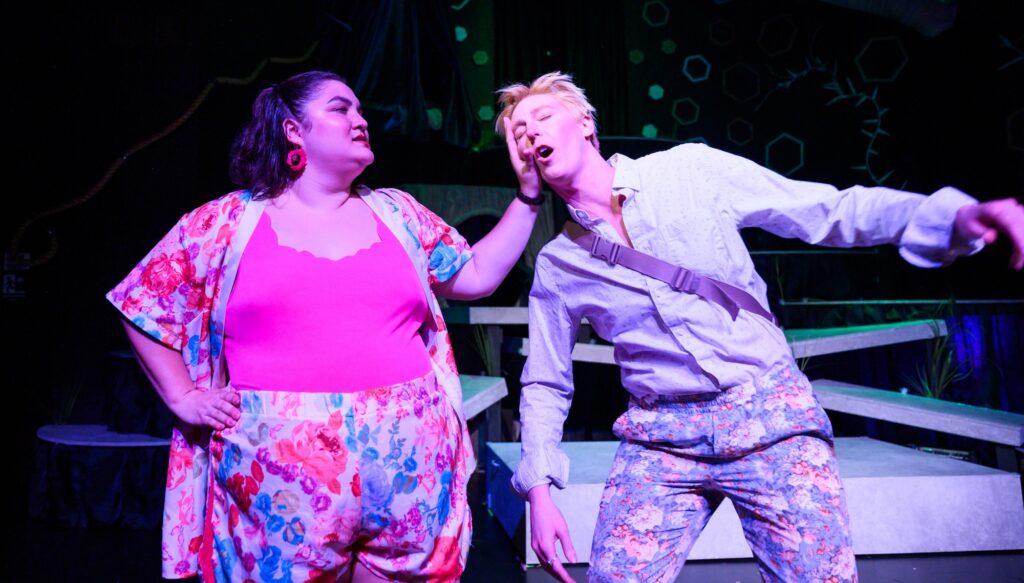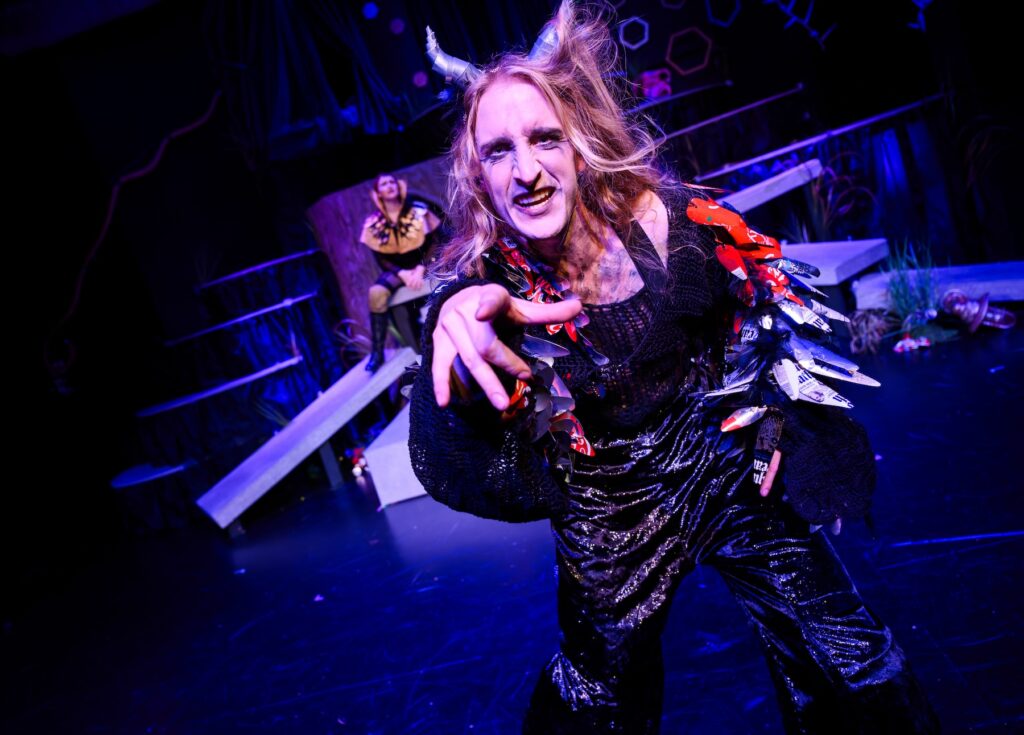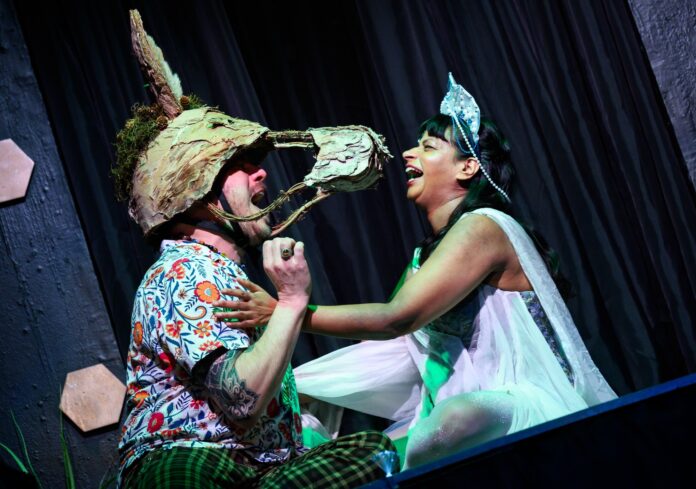Supposedly, there’s no wrong way to adapt Shakespeare. The benefit of being the author of the most recognizable English language public domain work aside from the King James Bible is that said work lends itself to no shortage of change while staying familiar. Granted, there are plenty of things an adaptor shouldn’t do (I’d never want to see a race-flipped version of Othello), but nearly everything is fair game. If anything, the most crucial aspect of adapting the bard is how you deal with the language: You can get rid of it all together (West Side Story, the ballet adaptations) or you can hang on every word and trust the intelligence of the audience.
William Hodgson didn’t stick to those rules. Although there’s no credited adaptor for his new Shotgun Players production of A Midsummer Night’s Dream (through April 27 at Ashby Stage, Berkeley), the choices made reflect his previous directorial work. Despite a director’s note saying how much he loves Shakespeare’s lyricism, his choices in this show reveal a director who 1. doesn’t trust (or understand?) the original text, and 2. wedges in jokes in modern dialogue in a poor attempt to improve the original. While the tack of updating/transforming the Bard isn’t unheard of—we have plenty of hip-hop Shakespeare, after all—this diversely-cast, potential-laden Midsummer flounders when it could fly.
As with SF Ballet’s gorgeous recent production, Midsummer should be ubiquitous enough not to warrant a detailed recap. Still: Hermia (Celeste Kamiya) loves Lysander (Devin A. Cunningham, filling in for G. Momah), but her father (Susannah Martin) wants her to marry the more respectable Demtrius (Fenner Merlick), who caught the eye of the mousy Helena (Rolanda D. Bell). Fairy King Oberon (Veronica Renner) wants to get back his wife Titania (Radhika Rao) by using a magic flower to make her fall for a beast. Through incompetence, Oberon’s sidekick Puck (Jamin Jollo) does what he’s told, but also complicates matters between the young couple. Naturally, a troupe of actors gets involved.

Hodgson’s last directorial effort for Shotgun was the uneven production of Passing Strange. He makes many of the same mistakes in this show that he did in that one. First and foremost is an inability to understand the nuances of the characters: He directs his actors to simply “go big” with their performances. Most of the cast do well with the classic text (including Cunningham, who was on-book for the opening weekend show I saw), but even the more skilled members begin to speak in a way that shows they weren’t given any direction regarding character development. It’s akin to a high school production directed by a teacher happy enough that the students memorized the lines, not that they understood them (which might explain the “thrown together” aesthetics of the set and costumes). And adding in modern dialogue for cheap jokes doesn’t help matters.
Most of questionable directorial decisions are personified by Oscar Woodrow Harper III’s performance as Nick Bottom. I don’t recall any previous Harper performances to know what his voice sounds like, but his inexplicable Southern drawl for Bottom makes no sense. Harper’s take on the narcissistic character is broad caricature making poor jokes that don’t seem to appeal to children (the Bard’s “Phoebus’ car” line is followed by a an utterance of “beep-beep”) or adults. Shakespeare’s work had no shortage of sexual double-entendres, but the ones thrown in here are like rejected lines from Family Guy. Goofy as he is on the page, there’s more to Bottom than chewing the scenery.
Which brings me to the other major directorial faux pas of the show: the set. Passing Strange saw Hodgson’s cast trying to negotiate an over-complicated set by Romello Huins. The Midsummer set by Sarah Phykitt is nearly identical to Huins’, but Hodgson hasn’t gotten any better at moving performers around the ascending design. As before, he pushes all the action so far downstage that it’s obscured by the front row audience, or he pushes everything to the top floor, where even high seats’s views are obscured by hanging lights and wires. The middle ground is all-but-abandoned, as if the actors were expressly forbidden from entering it unless crossing from one side to another. In fact, the center of that level begins to seem like a celestial black hole, given the way staging seems to form a halo around it.

Despite those poor choices, most of the performances work. The couples, in particular, all have good chemistry with one another. In fact, Renner and Rao make you want to see them in a full show about the magical monarchs. They infuse pathos and passion into the two that one wishes followed through for the entire show. Also of note was Erika Bao’s atmospheric soundscape, even if it frequently drowned out the cast during crucial exchanges. But again, what there is good in the performances is in spite of the direction, not because of it.
I saw the show during its first COVID-safe Sunday matinee. Although the audience was pretty well-behaved about their masks, my Aranet4’s CO² readings were up to 2801ppm by the show’s end. A livestream of the show will air on their website on April 4, with on-demand replay available starting April 21.
Midsummer’s “quintessential rom-com” reputation makes its appeal easy to understand, and the high recognition of the characters explains why it’s still performed by school kids and seniors alike. That doesn’t mean it’s impossible to do wrong. An abundance of head-scratching directorial decisions make a misfire of a play that’s been an easy win for over 400 years. If you’d like to see a diverse, queer-friendly cast reciting the classic lines, you’ll definitely find it here, but it’s not as sharp as it could have been.
MIDSUMMER runs through the April 27 at the Ashby Stage, Berkeley. Tickets and further info here.




